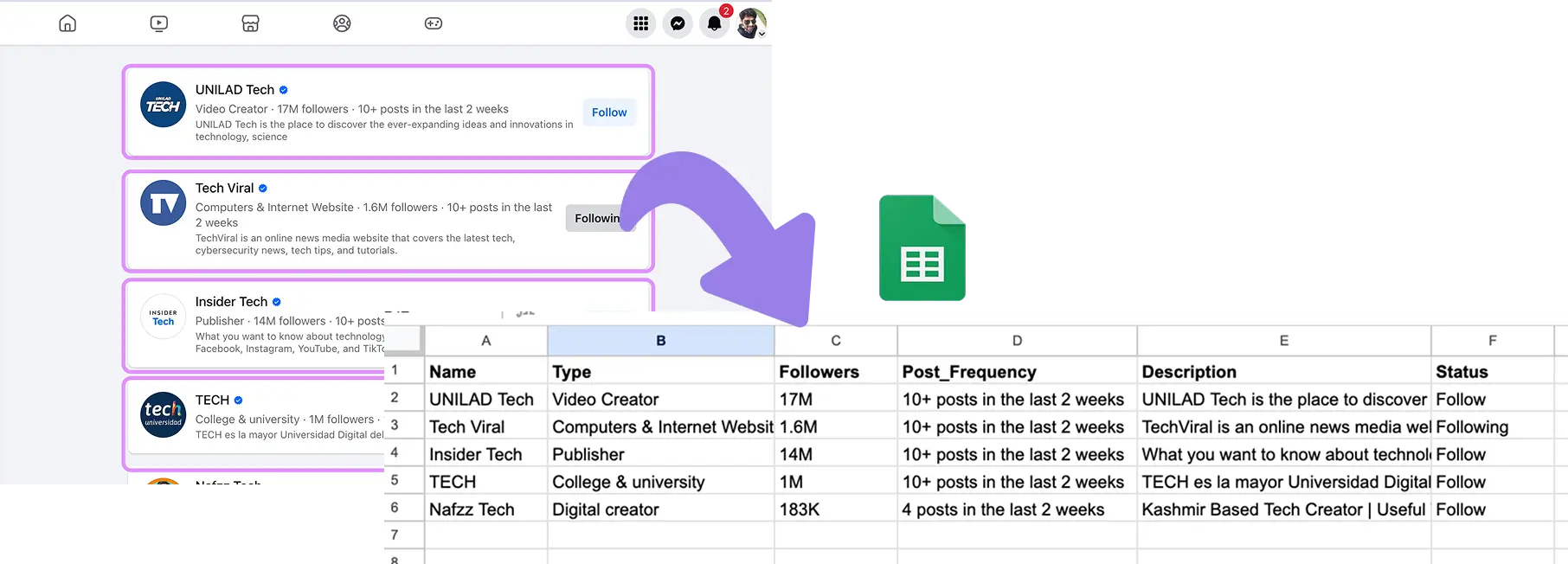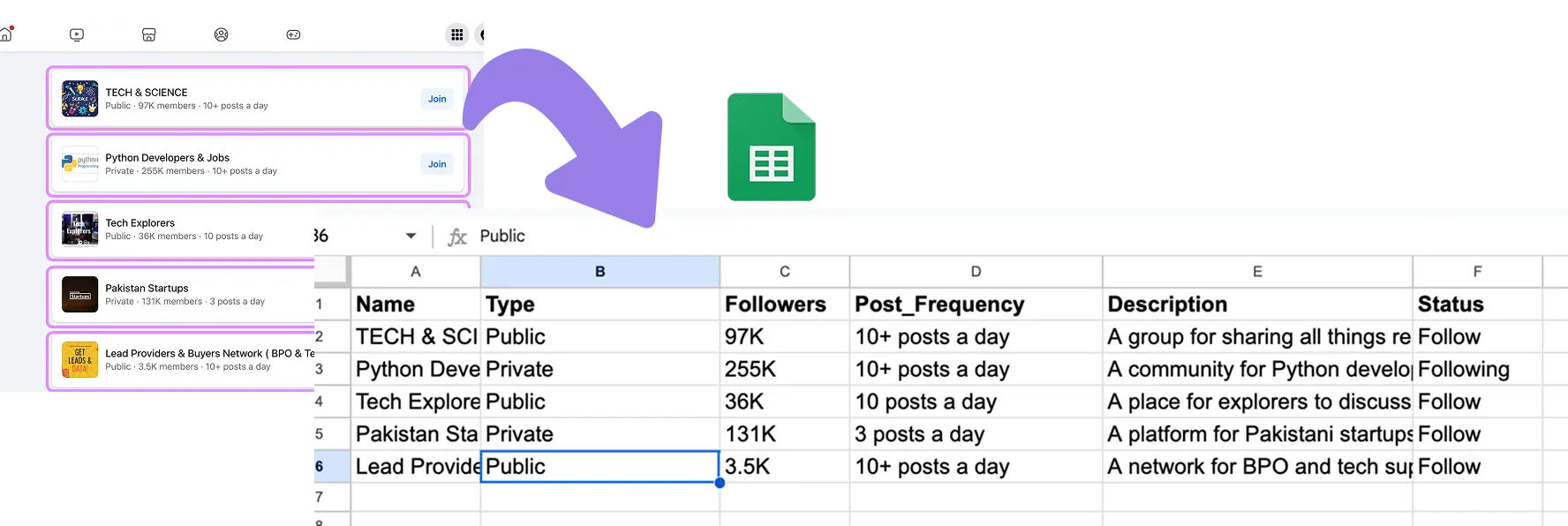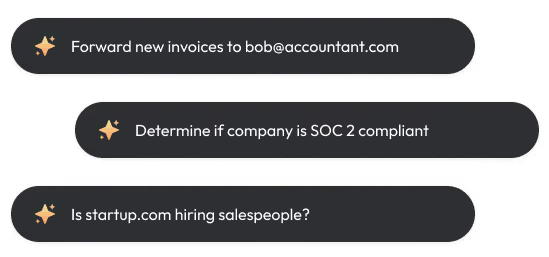Facebook lead gen ads reduce friction, improve conversion rates, and reduce costs.
Use AI to automate lead generation and gather data to set up Facebook lead ad campaigns.
By the way, we're Bardeen; we build an AI agent for sales: automate lead gen and outreach.
Are you struggling with low lead volume? Difficulty reaching a specific target audience? Need for a more efficient and scalable lead acquisition strategy? Facebook lead gen ads might be the answer you are looking for!
According to recent statistics, over 70% of sales and marketers use Facebook for lead generation, and businesses see an average conversion rate of 12% on their lead ads.
Bardeen can help with out-of-the-box, fully customizable, templates for Facebook automation, such as:
This comprehensive guide will walk you through everything you need to know, from setting up your first lead ad campaign to advanced optimization techniques.
How do Facebook lead ads work?
Facebook lead generation is the process of creating ads that feature a lead form, which users can fill out directly within the Facebook platform. When someone clicks on your ad, a form pops up with their pre-populated information, making it easy for them to submit their details.
Facebook lead gen ads were designed to remove friction and increase conversion rates. Here’s what a typical flow looks like:
- Step 1: User clicks on ad
- Step 2: User must fill out a form
- Step 3: User must confirm their information is correct
- Step 4: User accepts terms and conditions, then the form is submitted
Traditional lead generation methods often involve directing users to a separate landing page or website to fill out a form. This extra step can lead to drop-offs and lower conversion rates.
In contrast, Facebook lead gen ads keep users within the Facebook platform, providing a seamless experience. The pre-filled information feature also sets Facebook lead generation apart, as it minimizes the effort required from users, resulting in higher completion rates.
Facebook lead ads vs. traditional lead ads
By using lead gen Facebook ads, businesses can reach their target audience and generate high-quality leads without directing users to an external website. This experience encourages more people to provide their contact information, resulting in a higher volume of leads for your business. Here’s a comparison with old-school ads:
Best practices to generate high-quality leads on Facebook
One of the most common issues advertisers face is a lack of interest or sales-qualified leads. Luckily, that is a fairly easy problem to solve.
When creating a Facebook lead ad, you can customize various elements to suit your business needs:
- Ad format: Choose from single image, video, carousel, or slideshow formats.
- Lead form: Design your form with custom questions and fields.
- Thank you screen: Display a confirmation message and provide additional information or offers.
- CRM integration: Sync leads directly with your CRM systems, such as HubSpot, Salesforce, or Mailchimp, for immediate automated follow-up.
By analyzing and tweaking these features, you can improve the lead quality and get a higher return from your ads budget. Here are best practices worth keeping top of mind:
1. Target the right audience
- Use “custom audiences” to target specific groups.
- Investigate “lookalike audiences” to find new prospects similar to existing customers.
- Utilize detailed targeting to refine your audience based on specific criteria like interests and behaviors.
2. Optimize your lead form
- Make the form longer and add more qualifying questions.
- Use custom questions to filter out low-intent leads.
- Add a multiple-choice question instead of open-ended fields for better accuracy.
3. Optimize your lead form
- Clearly communicate your value proposition and use action words to motivate your audience ("Start your free trial today!")
- Use high-quality visuals
- Test different ad formats to see what resonates best.
4. Set up instant follow-ups
- Automate lead responses via email or SMS.
- Use CRM integrations to automatically nurture leads.
- Redirect users to a thank-you page with the next steps.
These best practices will help you maximize the quality of your lead gen Facebook ads. Next, I’ll show you how to create your first Facebook ad campaign.
Step-by-step guide to creating a Facebook lead ad campaign
Setting up Facebook lead ads is a straightforward process that involves creating a campaign, designing an effective lead form, targeting the right audience, and integrating with your CRM system. Let’s get started.
1. Set up the Facebook lead ads campaign

Select the lead generation objective in Ads Manager to create a Facebook lead ad campaign. Choose your target audience, budget, and ad placement. Then, design your ad creative and lead form, ensuring it aligns with your brand and offers value to potential leads.
2. Design high-converting lead ad forms
.webp)
A well-designed lead form is crucial for the success of your Facebook lead ad campaign. Keep the form short and simple, only asking for the most relevant information. Use a clear and compelling headline to communicate the value of submitting the form.
Customize your form with your brand colors and imagery to create a personalized experience. Consider using conditional questions to gather more specific information based on user responses.
Test different form layouts and questions to optimize for higher conversion rates. Finally, set up a thank you screen to confirm submission and provide the next steps.
3. Target the right audience with your lead ads

Effective audience targeting is key to generating high-quality leads with Facebook lead gen ads. Use Facebook's robust targeting options to reach people most likely to be interested in your offer. Create custom audiences based on website visitors, email lists, or engagement with your Facebook page.
Lookalike audiences can help you find new people similar to your existing customers or leads. Experiment with different targeting criteria and monitor your ad performance to refine your audience over time.
4. Integrate Facebook lead ads with your CRM or automation platform

Integrating your Facebook Lead Ads with a CRM or marketing automation platform will accelerate your sales lead management. You can quickly follow up and nurture new leads through the sales funnel by automatically syncing them into your system.
Facebook offers native integrations with popular CRM platforms like Salesforce, Mailchimp, and HubSpot. You can also use third-party tools like Bardeen to connect Facebook lead ads with 100+ other applications.
Next up, we'll dive into automating your Facebook lead generation to ensure you're getting the best return on your advertising investment.
How to automate Facebook lead generation?
Managing your Facebook leads is even easier when you integrate your ads account with your CRM or email automation platform. Here’s how you can instantly create new contact records, enrich existing contacts, and send automated follow-ups without lifting a finger:
1. Connect Facebook lead ads to your CRM or email marketing tool. Leads will be automatically sent to your CRM.
2. Set up automated follow-ups. You can now create personalized messages to be sent at regular intervals via email or SMS.
3. Set up notifications. Make sure relevant team members are aware of new leads entering the system.
4. Automate retargeting ads. Use the custom audiences tool to select leads that don’t convert right away.
5. Create a reporting dashboard. Your CRM will automatically update reports with relevant metrics such as lead volume, lead status, and lifecycle stage.
Platforms like Bardeen, HubSpot, Zapier, and Mailchimp are great for automating Facebook lead ads.
What are the average costs of a Facebook lead generation campaign?
Facebook ads costs have been relatively stable since 2021, in contrast to Google ads which have increased steadily. You can run a Facebook ads campaign on virtually any budget, but how much do you have to spend to see results?
PPC experts recommend a starting budget of around $20 per day for small businesses and running about 15 ad sets for a week. Bigger, more established businesses might want to start with $30 - $50 per day and scale up from there.
However, keep in mind that initial investment is just a test to gather information. You can use that information to refine your targeting before spending more. Metrics such as Click-Through Rate (CTR) and Cost-Per-Customer (CPC) will tell you how your ads are performing.
The Facebook lead ads metrics below list some industry benchmarks you can use to measure your ads performance:
Optimizing Facebook lead ad performance
By A/B testing ad creative, improving lead quality, leveraging analytics, and learning from successful case studies, you can fine-tune your lead generation campaigns for maximum results. Let’s see how:
1. A/B testing lead ad creative and copy
A/B testing involves creating multiple versions of your lead ad with different images, videos, or copy to determine which elements resonate best with your target audience. By comparing the performance of each variation, you can identify the winning combination that drives the highest conversion rates and lowest cost-per-lead.
For example, a real estate company might test two different ad images - one showcasing a stunning interior and another featuring a happy family in front of their new home. By analyzing the results, they can determine which image is more effective at attracting qualified leads.
2. Strategies to improve lead quality and reduce CPL
To improve the quality of your leads and reduce your cost-per-lead, consider implementing the following strategies:
- Use lead ads that are highly relevant and targeted to your ICP (ideal customer persona)
- Create compelling ad copy and visuals that clearly communicate your value proposition
- Optimize your lead form by asking only essential questions and using conditional logic
By focusing on quality over quantity, you can attract leads that are more likely to convert into customers, ultimately reducing your cost-per-acquisition.
3. Tracking and measuring lead ad performance with Facebook analytics
Facebook analytics provides valuable insights into the performance of your lead ads, allowing you to track key metrics such as conversion rates, cost-per-lead, and lead quality. By regularly monitoring these metrics, you can identify areas for improvement and make data-driven decisions to optimize your campaigns.
For instance, if you notice that a particular ad set generates a high volume of leads but at a higher cost-per-lead, you may need to adjust your targeting or ad creative to improve efficiency.
4. Learning from successful Facebook lead ad campaign case studies
Studying case studies of successful Facebook Lead Ad campaigns can provide valuable insights and inspiration for your own lead generation efforts. Look for examples within your industry or niche to learn how other businesses have effectively used lead ads to achieve their goals.
In the next section, we'll explore advanced tactics for Facebook lead generation that can help you take your campaigns to the next level.
Advanced Facebook lead generation strategies
Take your Facebook lead generation efforts to the next level with these advanced strategies:
1. Customize your lead forms with conditional logic
Conditional logic allows you to show different questions based on a user's previous answers. This enables you to create a more personalized and relevant experience for each lead.
For example, if you're a real estate company, you could ask leads if they're interested in buying or selling a property. Based on their answer, you can then show them specific questions related to their needs, such as their budget or timeline. This can increase form submissions by as much as 120%, as reported by Unbounce.
2. Implement lead scoring and nurturing for higher quality leads
Not all leads are created equal. By implementing lead scoring, you can assign a value to each lead based on their likelihood to convert. This lets you prioritize your follow-up efforts and focus on the most promising leads.
Once you've identified your high-quality leads, it's important to nurture them with targeted content and offers. Use email marketing, retargeting ads, and other channels to keep your brand top-of-mind and guide leads through the sales funnel.
By combining lead scoring and nurturing, you can create a more efficient and effective lead generation process that drives better results for your business.
3. Combine lead ads with other Facebook ad formats
While lead ads are a powerful tool on their own, they can be even more effective when combined with other Facebook ad formats. For example, you could use video ads to build brand awareness and then retarget viewers with a lead ad.
You could also use carousel ads to showcase multiple products or services, and then direct interested users to a lead form for more information. By creating a full-funnel campaign that leverages multiple ad formats, you can guide users through the customer journey and maximize your results.
4. Stay ahead of the curve with new features and beta opportunities
Facebook is constantly rolling out new features and beta opportunities for lead generation. By staying up-to-date with these developments, you can gain a competitive edge and be among the first to test new strategies.
For example, Facebook recently introduced lead gen ads for Messenger, which allow businesses to collect leads directly within the messaging app. By being an early adopter of new features like this, you can stay ahead of the curve and find new ways to connect with your target audience.
For an even more efficient approach, consider sales prospecting automation to accelerate your workflow.
Facebook lead generation ads examples
Facebook lead gen ads offer a variety of ways to capture valuable customer information directly within the platform. Here are a few Facebook lead ads examples to show you how versatile and effective they can be for different purposes:
Example #1: Lead magnet

A lead magnet (sometimes known as a premium content offer) is a great way to collect and qualify your leads. Lead magnets are often downloadable Ebooks or whitepapers, but they can be anything — an interactive tool, a video series, or a downloadable template. This example of a Facebook lead ad shows how Ads Espresso grew their lead list:
Example #2: Free trial

What better way to show the value of your software than by offering a free trial? Here is an example Facebook lead ad which shows how SEMrush was able to get more users:
Example #3: Event/tradeshow promotion

Are you hosting an in-person event? Want people to come visit your tradeshow booth? Facebook lead gen ads are a great way to create awareness and target local leads in a specific geographic area. Here are some examples of how Trustmary Group did it:
Example #4: Limited time offer

When you’ve got a time-sensitive offer, you have to tell everyone as quickly as possible. Facebook lead gen ads are the perfect medium. See how Duluth Trading CO was able to promote their holiday sales and give their sales a boost:
Get the most out of Facebook lead generation
Thanks for sticking with us through this comprehensive guide to Facebook lead generation! While it may seem like a lot to take in, mastering these strategies can make a big difference in your lead gen results. Don't be the marketer who misses out on valuable leads because they didn't take the time to learn these advanced tactics!
Understanding Facebook lead generation is crucial for businesses looking to acquire new customers and grow their online presence. Don't miss out on the opportunity to expand your customer base.
Master Facebook lead generation today, or risk falling behind your competitors in the ever-evolving digital landscape!










.svg)
.svg)
.svg)
